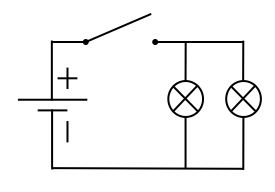Parallel Circuits

If you combine two consumers (e.g. light bulbs or resistances) with conductors in such a way that you get crosspoints, you have created a parallel circuit.
The two consumers are then parallel (and NOT in a line) to each other.
In such a crosspoint the electrical current splits up in two directions - like a river that splits up in two arms.
The amperage of the single partial current depends on the consumers in the single branch lines.
The sum of all the amperages of the partial currents together equals the total amperage.
In the single parallel branch lines, the amperage can be different but the voltage is always the same.
The total resistance in parallel circuits can be calculated by using this formula:

In this formula you can see that the total resistance is lower than the single resistances of the single branch lines.
Halogen lamps are an example in your everyday life. They are always installed in parallel circuits.

